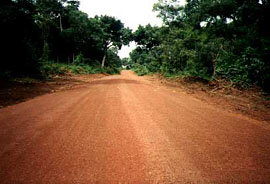 INFRASTRUCTURES INFRASTRUCTURES
 INFRASTRUCTURES IMPROVE AND EXPAND INFRASTRUCTURES IMPROVE AND EXPAND
Guinea’s dream of attracting foreign investment implies a radical improvement of its infrastructures. Two years ago the capital city, Conakry, did not have public lighting, roads were in a dreadful state and there were only 10.000 telephone lines in the whole country. Nationals and expatriates who have seen the spectacular changes occur affirm they could not believe what happened in such a short span of time. There is still plenty to do, mend or build, but the present government’s zeal to speed up the development process has indeed produced more than satisfactory results.
The modernization of telecommunications is an absolute priority for the minister of public works, Mr. Cellou Dalein Diallo. International investment has been searched for and found. January 1997 Guinea was connected to Internet USA, mostly thanks to US financial support, and Telekom Malaysia Berhad has taken over the national telecommunications operator.
 NEW ROADS FOR A NEW ERA NEW ROADS FOR A NEW ERA

In the 1980s the road network was so limited and roads were in such bad conditions that 150 km trips could take 2 days. Most cities were isolated, as was the country from its neighbors. Access was restricted to rural tracks. When President Touré took office in 1984, he realized roads had to be not only constructed, but also kept in good condition. The road network has increased four-fold since then. But it is only in the past 5 years that changes have been really noticeable. In 1995 there were 13,900 km of roads, of which 1,950 km are asphalted. Rural tracks cover around 5,600 km
 ENDING UP WITH GUINEA’S ISOLATION ENDING UP WITH GUINEA’S ISOLATION
Mr. Cellou Dalein Diallo, Minister of Public Works, the largest operating ministry ( the complete name is Ministry of Transport, Public works, Telecommunications and Environment) gets excited when he talks about the ambitious investment program for roads development. In the next 5 years all major roads will be asphalted. |
For this he counts on help from the EU and Arab funds. Plans include linking Guinea with 3 of the most developed neighbors: Ivory Coast, Senegal and Mali (with a cost of US$141 million). The construction of most of these roads will be done by the Russian engineering company Enco-5.
 RUSSIAN ENGINEERING IN GUINEA RUSSIAN ENGINEERING IN GUINEA
When travelling up country it is surprising to see the good state of the main roads. Unfortunately the same does not apply to the cities' roads, although new efforts are being made to improve the deteriorated state of side roads in traffic-jammed Conakry. Enco-5 is determined to reshape the city map. This Russian company, created in 1990 by an intergovernmental agreement between Guinea and Russia, has already built 70% of Conakry’s roads, and plans for further improvement of the city road network are well under way.

When Director General Mr. Viatcheslav Minaev first arrived, Enco-5 's only plan was to build the highway known as "Le Prince". After the dismemberment of the Soviet Union Enco-5 went private and has become a very profitable company ( its monthly earnings are US$2 million ), diversifying its activities which now encompass the construction of bridges, harbors, buildings and even airport landing fields.
 ARRIVALS TO CONAKRY ARRIVALS TO CONAKRY
However, Enco-5 has not had the chance to build many landing strips. Guinea only has one international airport, Conakry-Gbesia, and a few local ones. The Conakry airport is managed by the largely incompetent SOGEAC. Delays in arrival and departures, baggage loss and rampant corruption of immigration officers are some of the inconveniences passengers arriving or leaving the country have to face. |

